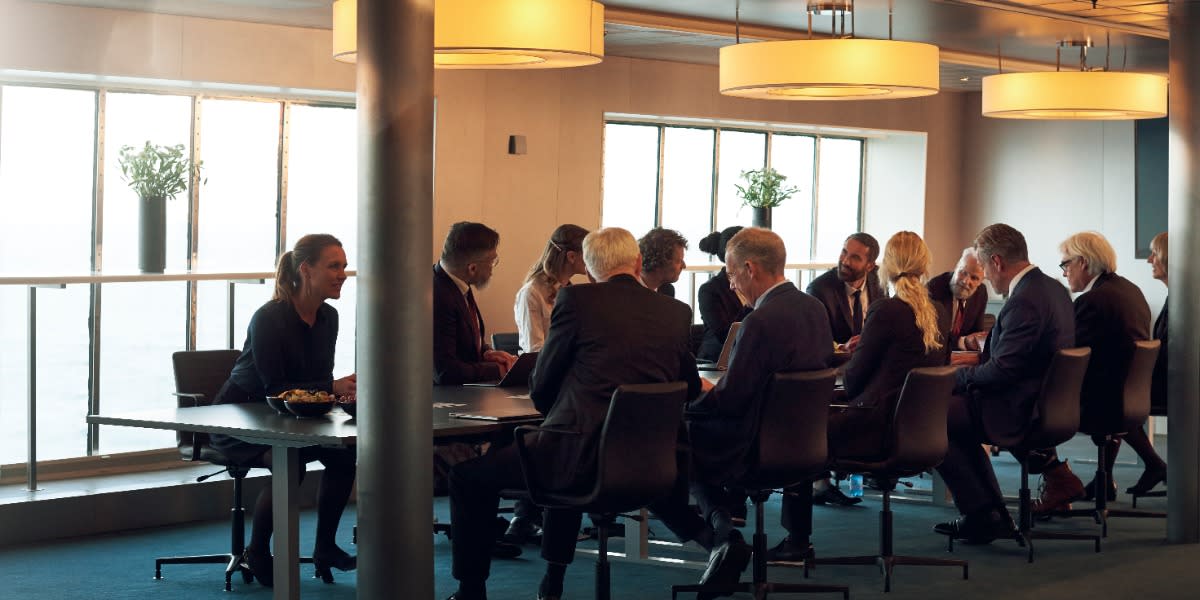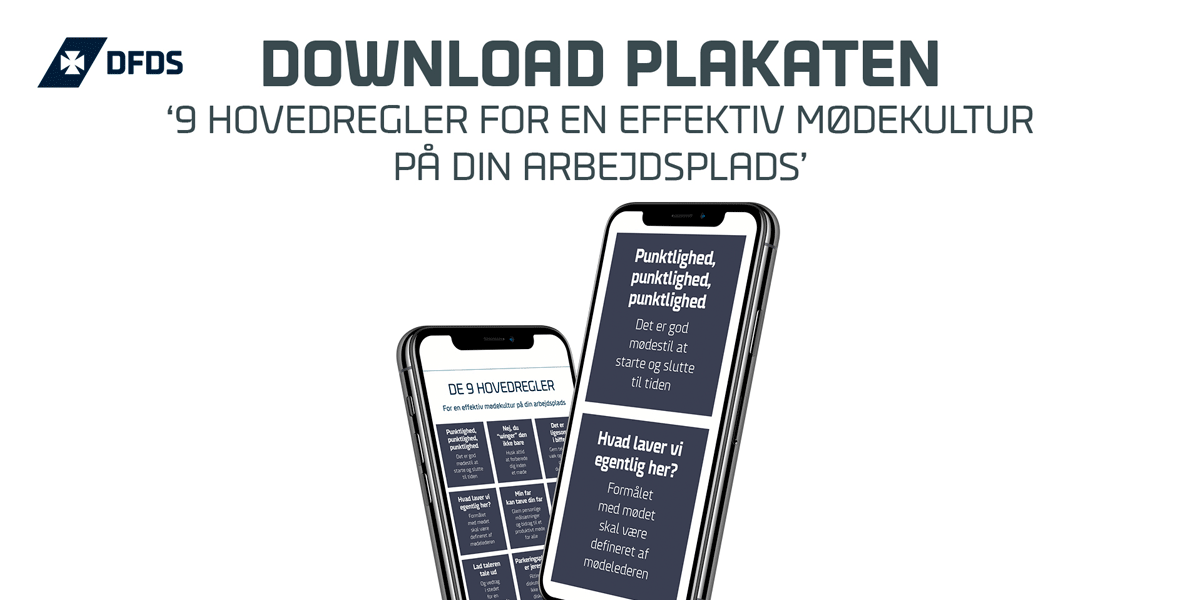
4 meeting types: succeed with meeting planning for any work situation
What is cardinal sin number one in relation to effective meeting time in Danish workplaces? Delays and lack of preparation time are undoubtedly among the biggest. But the worst is, in fact, a whole third: the absence of a clear meeting purpose.
Virtually all participants are familiar with the overall theme when settling into the meeting room. Sales. Economy. Recruitment. A specific customer or strategy.
Participants can easily put a headline on the meeting. It's just not the same as knowing the purpose of the meeting.
A meeting is just a meeting mentality
What is the consequence of unclear meeting purposes? Simply that meeting efficiency drops.
Arne Stentoft can confirm this.
He is a certified facilitator at Potentialehuset, which advises municipalities, regions and other large organizations in meeting management and team development, etc. The City of Copenhagen, KL and PostNord are among the more than 300 organizations that Potentialehuset has worked for.
According to Arne Stentoft, the absence of a clear purpose is a recurring meeting killer in the country's workplaces.
“A clear purpose is incredibly central to the effectiveness of a meeting. All participants must know exactly why they are meeting and what they should get out of the meeting. But it is definitely one of the things that sometimes lags ‚« says Arne Stentoft.
He experiences that the awareness of how diverse the purposes can be, and what success criteria the different purposes entail, is lost in the bustle of everyday life. Understandable enough by the way.
“In many organizations, a meeting is just a meeting. We do as we have always done and there is no pronounced difference in the types of meetings. It's quite common. Conversely, I can also see that when organizations start thinking in different types of meetings, and what they specifically have to lead to, they get much more out of their meeting time than they did before, ”says Arne Stentoft.
The four major meeting types
To get the most out of our meeting time, in this article we take a closer look at the four most common types of meetings:
- The information meeting
- The idea meeting
- The problem-solving meeting
- The decision meeting
Once you have read the article, you know in which situations the individual meeting types strike and how both the chair and the meeting participant prepare for a productive meeting.
The information meeting
Purpose
The information meeting must raise the knowledge level of the meeting participants
The role of the chair of the meeting
- Prepare the agenda
- Identify which of the meeting participants should share information for the meeting and in which areas
- Inform the individual meeting participant about his or her contribution to the meeting and how long he or she has available for the meeting
- Facilitate the question round for the meeting itself. The question round must not develop into a discussion. Discussion does not belong in an information meeting
- Hand out relevant material for the participants' preparation
The role of meeting participants
- Prepare presentation of information
- Prepare to receive information and possibly ask questions. Orient yourself in the handed out material
Protip
One-way communication inevitably fills a lot for an information meeting.
The chair of the meeting must therefore be aware of the risk that the passive meeting participants in particular will lose concentration during the meeting time. There should be time set aside for questions and preferably regularly during the meeting. In general, the information meeting should be kept as short as possible. Consider whether all meeting participants need to be present throughout the meeting.
Criteria for success
The information meeting has provided the desired knowledge sharing between the participants
The idea meeting
Purpose
The idea meeting must facilitate idea generation
The role of the chair of the meeting
- Prepare the agenda: For which task solution do we generate ideas? The chair of the meeting can advantageously break down the overall task into smaller sub-tasks. The more concrete the tasks, the more concrete the ideas become.
- Share the agenda with the meeting participants well in advance. Preferably a few days before the meeting. In this way, you activate the participants' idea generation even before the meeting begins.
- Set the criteria: Cheap, quick to implement, durable in the long run or otherwise. What should the participants prioritize in their idea generation?
- Consider the composition of meeting participants. Many departments may want to be represented, but the composition must be balanced to create the most idea-generating dynamic.
- Remedies: Whiteboard, post-its, flipchart, markers and pictures. The idea meeting is a distinctly active and interacting meeting. It is counterproductive if the meeting participants sit behind each their computer. The chair of the meeting must procure the necessary remedies before the meeting.
The role of the meeting participant
- Orient yourself in the handed out material
- Be ready to contribute from start to finish. The idea meeting is a joint effort all the time.
Protip
The chair of the meeting must be aware of the difference between the open phase and the closed phase in idea generation.
There is no room for discussion or scrutiny in the open phase, which is all about getting ideas on the board. It is in the closed phase that participants begin to qualify the ideas. Many idea meetings go wrong because the two phases are mixed together.
Criteria for success
The idea meeting has provided executable ideas with the support of the relevant stakeholders
The decision meeting
Purpose
The decision meeting must result in a decision
The role of the chair of the meeting
- Define which decision to make
- Define the criteria to be taken into account
- The meeting participants must have all the necessary material handed out in advance. In time to be able to understand and assess the scope of the decision
- The chair of the meeting must chair the meeting and focus on the purpose of the meeting. Discussion is necessary, but a decision must be made. The decision is the purpose of the meeting.
- Make sure all participants accept the decision
- Record the decision
The role of the meeting participant
- Orient yourself in the handed out material
- Reflect on the possible outcome of the meeting
- Prepare mentally to engage in a discussion where compromise and understanding of divergent attitudes are necessary
- The participants in the meeting must agree that a vote may be necessary and respected
Protip
The decision-making meeting is deeply dependent on the participation of the right people. Neither too many nor too few should join. It is important that the participants are clarified and ready to make a decision. Participants must, for example, consult with the relevant stakeholders before the decision-making meeting.
Criteria for success
The meeting participants have made a decision
Conclusion: Idea generation methods with the best results
Companies can advantageously implement the above principles.
Most important, however, is to recognize the different purposes of meetings. Implement the designations for different meeting types in the internal communication. It will make a big difference to the quality of meetings in your workplace.
Meeting efficiency is significantly increased when all participants agree with the same overall premise. When all participants know the type of meeting and the purpose of the meeting. It will be easier to work in the same direction right from the beginning of the meeting. Even though disagreements and challenges may still arise.
Therefore: Write the meeting type in the heading for all meeting invitations. It is a simple but effective step towards a more effective meeting culture.

9 MAIN RULES FOR AN EFFICIENT MEETING CULTURE AT YOUR WORKPLACE
Do you want more out of your meetings? Give yourself and your colleagues a daily reminder of the recipe for the good meeting with this poster, which lists 9 main rules for an effective meeting culture in the workplace.
Download the poster now

MEETINGS AND CONFERENCES AT SEA
Do you want to hold a meeting or conference that is a little out of the ordinary? Then take the Oslo boat from Copenhagen, and experience an exciting alternative to the traditional conference centers.
Do you want to increase the results and sharpen the relations at the next business meeting, conference and company event? Our modern and spacious ships offer unique and unforgettable surroundings for all kinds of business meetings, conferences and corporate events.
